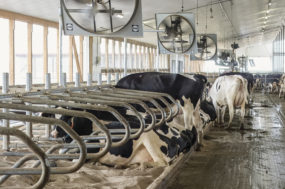Farming has seen significant structural changes in the past years, including what is raised or grown and how it is done. “Going big” is an industry tendency that has accelerated for several decades. Nonetheless, other producers are increasingly going small, but in an unexpected way: mini-livestock.
Or in other words, bugs.
Largely owing to climate concerns, there has been a notable increase in insect farming. While already common in Thailand and China, industrial-level insect production is gaining new interest in places such as Europe, the U.S. and Canada. Investment in insect products as a replacement to fishmeal and as a partial substitute to animal feed has spurred startups around the globe. Nonetheless, some have bigger ambitions. Several scientists suggest that the widespread human consumption of insects may one day be necessary to feed the world.
Farming insects is nothing new. In addition to beekeeping, silkworm production dates back to the 4th century BC in China. Mealworms are commonly used as a protein substitute in animal feed, and many Eastern countries harvest various types of insects for cosmetics or other additive uses. Additionally, it turns out that there are a lot of ways to prepare a cricket. In fact, although not very common in the West, it is estimated that a quarter of the world’s population regularly eats insects.
Some are betting on that number to increase.
Recently, a startup company called Ÿnsect started a vertical mealworm beetle farm in Dole, France. Trays reaching 17 yards in height house billions of beetles, with automated systems recording growth, moisture and environment temperature. Once the beetles reach adulthood, they are killed via a steam bath and processed into oil, protein and fertilizer. In addition to opening a second, larger plant, Ÿnsect has also purchased a mealworm production center in Nebraska. They are looking at opening 15 plants in the next 10 years. Meanwhile, their fellow French competitor, nextProtein, farms black soldier flies to be ground into fish and animal feed.
Proponents of insect farming, especially as a human food source, point to the nutritional advantages of bugs. Cricket has nearly the same protein content as beef, and some bug species can be a useful source of micronutrients and probiotics. Crickets and mealworms are also high in vitamin B12, riboflavin and vitamin A. The fatty acid composition of certain species is comparable to that of fish, offering additional health benefits.
Those pushing for further development of insect production suggest that it is an environmentally conscious way to meet the future food demands of the world population. Requiring less land use per pound of protein, insects are also said to be six times more efficient in feed conversion than cattle. Insect farming has been hyped as creating significantly less greenhouse gases, as well as being a more economical source of protein production.
Nonetheless, there are others that see the uptick in bug farms as a fad. While there may be growing acceptance of using insect protein in animal feeds, the West is still a long way from feeling comfortable ordering “bug burgers” at a restaurant. For those looking to replace meat in their diets, plant-based alternatives are more established and an easier sell than insect products. Additionally, scientists have also raised concerns over the impact of insect farming on local ecosystems. Inevitably, farmed insects will escape into the wild, altering the balance of the surrounding environment.
With the rise of bug production comes a conversation that may not have been taken seriously before: Can insects feel? While the industrial production of traditional livestock must negotiate ethical concerns regarding the treatment of what is farmed, similar logic is being tested on insect farming. To what extent must we ensure that the housing and harvesting of insects are not just economical, but moral? The question is complicated by the fact that there hasn’t been significant research conducted to determine if insects are sentient – or in other words, can register pain. Additionally, some insects, such as the larval stage of the black soldier fly, prefer crowded conditions. While it may seem obvious that the same criteria applied to cattle are not applicable to crickets, what constitutes best management practices still needs to be nuanced.
While it may be unlikely that citizens in North America and Europe will be eating moths and crickets regularly at the dinner table any time soon, it doesn’t mean that it won’t happen someday. Icelanders didn’t eat horse meat until forced to by severe poverty in the early 20thcentury. Now it is consumed there regularly. If global food security cannot meet the population’s demand in the future, forthcoming generations in the West may become more comfortable with eating bugs. Until then, the industry has been establishing itself as a protein replacement in animal feeds, a trend that is likely to continue.



